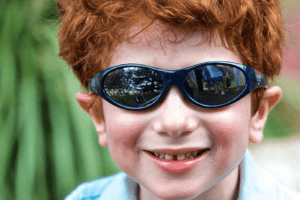Share

Are sunglasses for people with glaucoma?
Many patients experience discomfort from excessive light and glare including those with glaucoma. Patients with glaucoma often report blurred vision and glare sensitivity. In addition, the medications used to treat glaucoma can make the problem more noticeable.
Why do we notice glare?
The discomfort we experience from glare is caused by scattering of excessive visible light. Glare is worse when the eye is out of focus, has light pigmentation or with ocular diseases such as cataract, corneal disorders, dry eyes, retinal or optic nerve damage including Glaucoma.
Australian conditions expose us to excessive ultraviolet (UV) and visible sunlight. Our common European heritage with light pigmentation of skin and eyes does not protect us well in our sunny conditions.
Eye care practitioners recommend wearing sunglasses and a brimmed hat whenever you’re in the sun long enough to get a suntan or a sunburn, especially if you live at a high elevation or near the equator.
What about UV light?
Damaging ultraviolet (UV) rays are invisible but can cause damage to the external and internal structures of the eye Long term UV exposure can lead to skin cancers, pterygia, cataracts and macular damage.
The good news is that all reputable brand sunglasses conform to an Australian standard (AS/NZS 1067:2003, see below). Look for a lens with labelled category of at least 2 or preferably 3 when choosing sunglasses and you will be well protected. UV blocking is standard on all lenses regardless of the lens colour.
Many clear prescription spectacle lenses have an incorporated UV blocking tint. The majority of sunglasses and spectacle lenses are plastic not glass. Plastic lenses naturally block UV better than glass and with hard protective surface coatings are almost as durable as glass lenses. Plastic lenses can be tinted by dyeing the lens while glass lenses require surface coatings to applied.
How do I choose the best sunglasses?
Sunglasses are an easy solution that make life more comfortable when outdoors by reducing the amount of visible light reaching the eyes and surrounds. All reputable sunglasses block the invisible UV rays.
The darker the lenses, the more visible light they block. Typical dark sunglasses block 70% and transmit 30% of the visible light.
Your eyes would not be easily visible when viewed from the front behind 70% tinted lenses. 70% tinted lenses allow 30% of the light through.
The actual colour of the lenses is your own choice. 70% grey lenses are more common in Australia as they are dark enough to be comfortable in bright sunlight. Grey lenses also do not alter your colour perception. 70% Brown lenses are more common in Europe. These lenses reduce haze from smog and pollution by enhancing reds and darkening the blues making the sky appear bluer.
Large wrap around sports sunglasses also provide good protection but have limitations when attempting to incorporate a spectacle correction into them.
You should try lenses on before purchasing and ensure they are comfortable and the colour chosen suits you. Look through sample lenses to choose your preferred colour and density.
Are Polaroid lenses any better?
Polaroid filters cut out most light reflected from horizontal surfaces such as water or sand and are particularly useful for water sports or fishing. The direct light blocked by them is similar to other 70% grey tints.
Both plastic and glass lenses can have a thin polarizing tint integrated achieved by laminating the polarized film in between two thin half lenses.
Some frames are supplied with an integrated magnetic clip-on Polaroid filter which turns a clear pair of glasses into prescription sunglasses.
Plain 70% grey or brown Polaroid lenses are used in fit over sunglasses designed to fit over your prescription spectacles with the added advantage of side and wind protection.
A disadvantage of Polaroid filters is that when viewing some displays such as smart phones, tablet devices or GPS units, some characters may disappear from view.
In addition, laminated windscreens can appear to have dark patterns when viewed through these lenses.
How are other lenses tinted?
Tints can be a uniform colour over the whole lens or graduated from top to bottom. Plastic lenses are tinted by direct dyeing and many colour combinations can be created
Graduated lenses may have some advantages for specific tasks and are usually darker at the top of the lenses
Graduated tints are a little more difficult to create but as with full tints, the colours chosen and graduation type are entirely personal.
Thin metallic based surface coatings can be applied to all lenses to reduce internal reflections or achieve different colours. These coatings are applied under a vacuum during manufacture and need protective outer hard coating to ensure their durability. Most glass tinted lenses are coated.
Photo sensitive lenses
Photosensitive dyes can be incorporated into lenses. A common brand is Transitions: These lenses will then darken when exposed to UV light. They become automatically darker in minutes but need to be exposed directly to sunlight for this to work.
This can be a problem in a car as any laminated windscreen or window may block UV but not the visible light. The lenses may not be dark enough when driving, unless you happen to have a convertible car with the roof open. In general, you will not be aware of photosensitive lenses changing as they react automatically within minutes. Photosensitive lenses mimic the way our retinas adapt to changes in light level and photosensitive lenses can assist when our retinal adaptation has been affected by conditions such as macular degeneration or glaucoma.
The time taken for photosensitive lenses to alter from dark to light can be an issue if you were coming quickly from sunny conditions to indoor. You may need to wait a few minutes until the lenses are light enough for you. Many people use an additional tinted fit-over polarized sunglasses or a dedicated permanently tinted pair when driving. The photosensitive tints have a big advantage and can be very cost effective in that one pair of glasses can double as a clear and sunglasses pair.
Can prescription lenses be tinted?
All these tint options are available for prescription lenses that are either single vision, bifocal or multi-focal. If you currently wear a distance correction you should also have a tinted pair. Consider using the photosensitive lenses, clip on or fit over permanent tinted lenses or a dedicated pair of prescription sunglasses.
The good news is that sunglasses do not need to be expensive. Marketing with fancy brand names and claims of superior lenses is just that. If you consider sunglasses a fashion accessory or wish to advertise visible brand names on the sides then select the ones you prefer. Just make sure they are comfortable and fit well with lenses you prefer. Be aware you may be paying a lot for the image. Discuss all the options with your optometrist or eye wear provider and choose the sunglasses you prefer.
Eye safety
Remember, even the best sunglasses cannot protect your eyes from certain intense light sources. Arc welding, tanning lights, high altitude snowfields or gazing directly at the sun such as during an eclipse can all cause permanent damage to your eyes including retinal burns. These activities need specific protective lenses or should be avoided.
Australian sunglasses standards
There is an Australian/New Zealand standard (AS/NZS 1067:2003) that applies to Sunglasses and Fashion Spectacles sold in Australia. Spectacles are tested classified and labelled according to 4 categories
Under AS/NZS 1067:2003, sunglasses and fashion spectacles are classified as one of the following:
- Lens category 0: Fashion spectacles: Not sunglasses, as they have a very low ability to reduce sun glare and provide limited UV protection. These glasses can be used at night
- Lens category 1: Fashion spectacles: Also not sunglasses; they do provide limited sun glare reduction and UV protection. Fashion spectacles with category 1 lenses are not suitable for driving at night.
- Lens category 2: Sunglasses: These sunglasses provide a medium level of sun glare reduction and good UV protection. They are suitable for day time driving but too dark for night driving
- Lens category 3: Sunglasses: These provide a good level of UV protection and a high level of sun glare reduction. They are suitable for driving during the day
- Lens category 4: Sunglasses: These are special-purpose sunglasses that provide a very high level of sun glare reduction and good UV protection. They are too dark to use driving.
The standard also covers photochromatic lenses. Look for a lens category of at least 2 or preferably 3 when choosing sunglasses.



